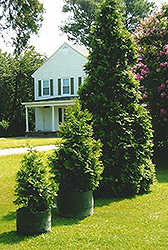It's all about ...
plants

Height: 15 feet
Spread: 6 feet
Sunlight:
![]()
![]()
Hardiness Zone: 5a
Other Names: Virgininan Cedar
Description:
A stately looking, narrowly pyramidal evergreen that grows uniformly and is perfect for privacy or wind screening; very resilient and resists ice and snow damage, grows in almost any soil type
Ornamental Features
Virginian Arborvitae is a dwarf conifer which is primarily valued in the landscape for its distinctively pyramidal habit of growth. It has rich green evergreen foliage. The scale-like sprays of foliage remain green throughout the winter. The shaggy brown bark adds an interesting dimension to the landscape.
Landscape Attributes
Virginian Arborvitae is a dense multi-stemmed evergreen shrub with a distinctive and refined pyramidal form. Its relatively fine texture sets it apart from other landscape plants with less refined foliage.
This is a relatively low maintenance shrub. When pruning is necessary, it is recommended to only trim back the new growth of the current season, other than to remove any dieback. It has no significant negative characteristics.
Virginian Arborvitae is recommended for the following landscape applications;
- Vertical Accent
- Hedges/Screening
- General Garden Use
Planting & Growing
Virginian Arborvitae will grow to be about 15 feet tall at maturity, with a spread of 6 feet. It has a low canopy, and is suitable for planting under power lines. It grows at a fast rate, and under ideal conditions can be expected to live for 50 years or more.
This shrub does best in full sun to partial shade. It prefers to grow in average to moist conditions, and shouldn't be allowed to dry out. It is not particular as to soil type or pH. It is somewhat tolerant of urban pollution, and will benefit from being planted in a relatively sheltered location. Consider applying a thick mulch around the root zone in winter to protect it in exposed locations or colder microclimates. This particular variety is an interspecific hybrid.
This plant is not reliably hardy in our region, and certain restrictions may apply; contact the store for more information.
